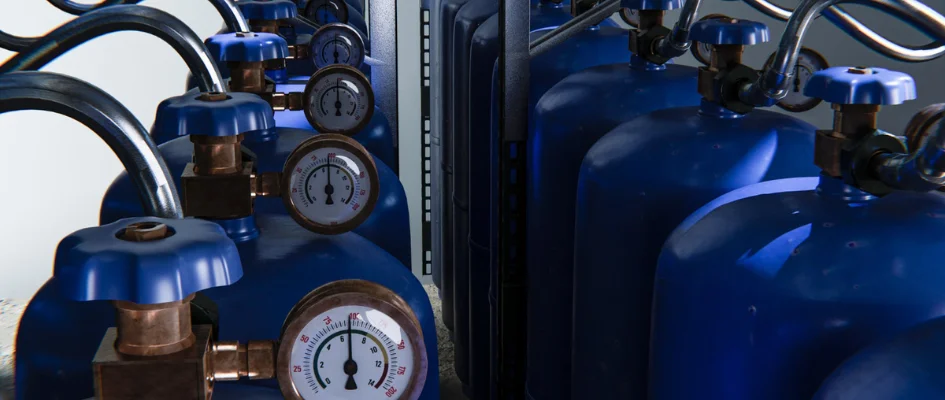
- devpneucleus
- Oct 14, 2025
- Blog
Hydrogen is the lightest and one of the most widely used industrial gases. Its unique properties, including low molecular weight, high diffusivity, and low viscosity, make accurate flow measurement both critical and challenging. Hydrogen mass flow meters engineered to deliver direct, repeatable, and traceable hydrogen flow measurements. These meters are suitable for research, industrial processes, energy production, and laboratory applications where precise hydrogen flow rate measurement is essential.
Properties and Applications of Hydrogen
Hydrogen is a colorless, odorless, and highly flammable gas. Its physical properties make it ideal for a wide range of applications but also create challenges for accurate measurement. Flow sensors calibrated for heavier gases cannot reliably measure hydrogen.
Hydrogen finds use across several industries:
- Energy and Fuel Cells: Hydrogen acts as a clean energy carrier. Accurate hydrogen flow measurement ensures efficient fuel delivery and optimal energy conversion.
- Chemical Industry: Hydrogen is essential in ammonia production, hydrogenation reactions, and petrochemical processes. Monitoring hydrogen flow enhances safety and efficiency.
- Research and Laboratories: Analytical instruments, gas chromatography, and controlled experiments rely on precise hydrogen gas delivery. A hydrogen mass flow meter ensures repeatable and traceable measurements.
- Leak Detection and Safety: Hydrogen’s small molecules make it ideal for leak detection. Using a hydrogen flow meter allows engineers to quantify leaks and maintain system integrity.
- Aerospace and High-Tech Applications: Hydrogen supports cooling, propulsion, and energy storage. Reliable hydrogen flow rate measurement is critical for process control and safety.
Why Dedicated Hydrogen Mass Flow Meters Are Necessary
Hydrogen’s low molecular weight, high diffusivity, and thermal conductivity require mass flow meters calibrated for hydrogen. Using meters designed for air or nitrogen can produce inaccurate readings.
Key considerations for hydrogen flow measurement:
- Hydrogen behaves differently in low-pressure or high-vacuum systems where molecular flow effects are significant.
- Heat transfer and flow behavior differ from heavier gases, affecting thermal sensors.
- Pneucleus mass flow meters for hydrogen are designed to maintain accuracy across varying pressures and temperatures, ensuring reliable readings for safety, research, and industrial control.
How Hydrogen Mass Flow Meters Work
Hydrogen mass flow meters utilize thermal mass flow measurement principles. A small heater warms the gas locally, and temperature sensors detect the resulting thermal difference caused by the flowing hydrogen. This method measures mass flow directly, removing the need for separate temperature or pressure corrections.
Key technical points:
- Measurement reflects direct hydrogen mass flow for accurate readings.
- Sensor geometry and thermal properties are optimized for hydrogen to provide linear and stable responses across wide flow ranges.
- Low-pressure or near-vacuum operation is specified to ensure valid measurements.
This technology enables precise monitoring in applications such as fuel cell supply, hydrogenation reactions, leak detection, and laboratory experiments.
Performance Specifications for Hydrogen Mass Flow Meters
Pneucleus flow meters for Hydrogen are factory-calibrated in accredited labs with traceability to national standards. Important performance specifications include:
- Accuracy and Uncertainty: Hydrogen-specific calibration ensures precise measurements.
- Repeatability: Maintains consistent short-term hydrogen flow readings.
- Turndown Ratio: Defines the usable flow range from minimum to maximum.
- Response Time: Critical for applications with dynamic flow changes.
- Pressure Drop: Ensures system performance, particularly in low-pressure hydrogen setups.
- Operating Conditions: Calibration remains valid across specified temperature and pressure ranges.
Custom calibration and on-site verification are available for non-standard conditions.
Selecting the Right Hydrogen Mass Flow Meter
Choosing the correct hydrogen flow meter requires careful evaluation of process requirements. Consider the following:
- Define required flow range, including steady-state and transient flows.
- Specify operating pressure and temperature ranges.
- Determine acceptable measurement uncertainty and repeatability.
- Confirm maximum allowable pressure drop in the system.
- Select mechanical connections, materials, and cleanliness compatible with hydrogen.
- Identify output interfaces, such as analog, pulse, or digital communication, for integration with control systems.
Best Practices for Reliable Hydrogen Flow Measurement
Proper installation and commissioning are essential for accurate hydrogen flow measurement. Key guidelines include:
- Maintain recommended straight pipe runs for inlet and outlet connections.
- Install meters in the correct orientation and avoid areas with rapid temperature fluctuations.
- Purge lines and meters to remove contaminants before calibration.
- Capture post-installation verification or perform field calibration checks.
- Use vibration isolation and secure mounting to prevent mechanical stress.
- Ensure proper grounding and shielding for meters with digital communication interfaces.
- Following these best practices ensures consistent, accurate, and validated hydrogen flow rate measurement across all applications.
